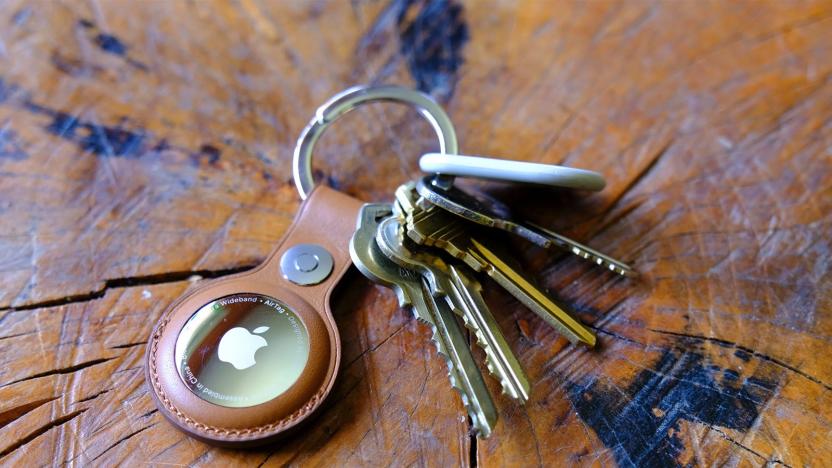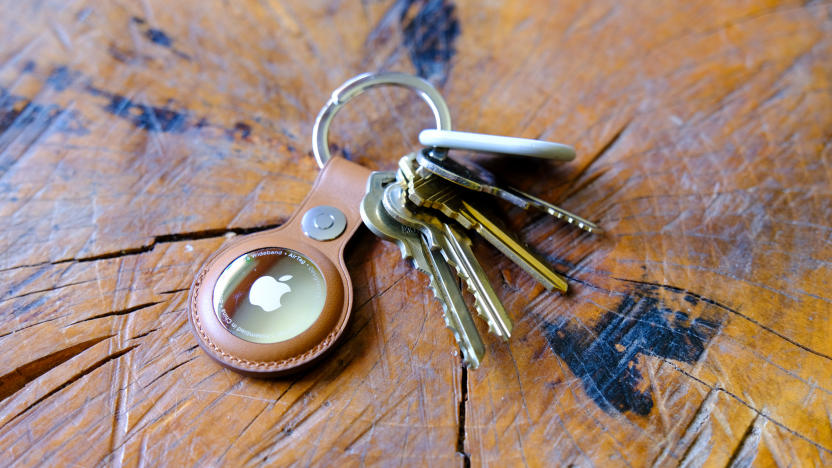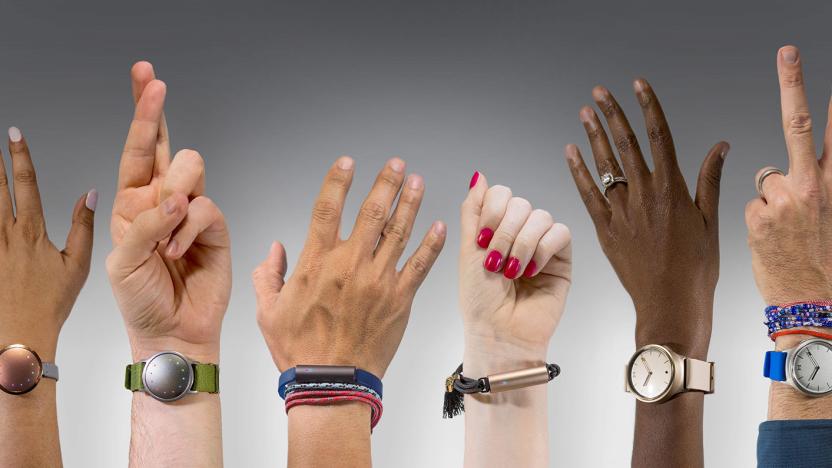trackers
Latest

Tile now offers $1 QR code stickers as a low-tech way to recover lost items
Tile has just launched "Lost and Found" QR labels that are a essentially a low-tech way to get your stuff back.

Vive's Mars CamTrack promises virtual set technology on an indie budget
HTC Vive has unveiled the Mars CamTrack, a system designed to put real-world actors into virtual environments Mandalorian-style.

Apple's AirTag drops to $25 for Amazon Prime members at Woot
Apple's AirTag is down to $25 at Woot for a single tracker if you're an Amazon Prime member.

Apple's new AirTags are as simple as they should be
If there’s one thing you should know about me, it’s that I. Lose. Everything. That character flaw, in tandem with a complete inability to see things smack in front of my face sometimes, means I’m perhaps the perfect person to try out Apple’s new AirTags. Good thing, then, that Apple sent along a few to test — along with a purple iPhone 12 running the new (and required) iOS 14.5 update.

DuckDuckGo upgrades apps to block hidden ad trackers
DuckDuckGo has given its browser extensions and apps a boost with more features meant to protect you from prying digital eyes. To start with, they now come with a built-in tracker blocker that prevents ad networks from following you around and collecting data on what you're doing. It even lists all the hidden networks it blocks, such as Google and Facebook, which you can access when you expand that section of the updated extension/app.

Customize your Misfit wearable to match your sense of style
The fashion and wearable industries clash like plaid and stripes, because tech companies are not that savvy on style and vice-versa. Misfit has some of the better-designed trackers and smartwatches out there, but it's making a bigger grab for the fashion crowd with a new service called Make Your Misfit. If you order the Phase, Ray, Shine 2 or upcoming Android Wear Vapor smartwatch, you can mix and match from a wide variety of device and strap colors, then quickly see how that looks.

Google Fit gets a colorful redesign and improved goal setting
Google has rolled out a major Fit update with a complete visual redesign, new watch face and features for Android Wear, a new home screen widget, more detailed goal-setting and more. Version 1.57.50 is the company's biggest update to the app in quite awhile, and appears to be a big part of the Android Wear 2.0 overhaul Google promised at I/O last month. The changes are apparent from when you first open it, as the previous, rather sparse home screen now has images, charts and a lot more color.

Larklife fitness tracker syncs your data over Bluetooth, knows when you're running instead of walking
In case you haven't noticed, fitness gadgets are having something of a moment right now. The past year alone has seen the launch of Nike's FuelBand, the ill-fated Jawbone Up and a refreshed line of Fitbit trackers. Now another product is arriving that promises to do basically the same thing -- namely, track your activity, sleep patterns and food intake using a wearable gadget and mobile app. That thing you see up there is called Larklife and for now, at least, it works exclusively with iOS devices. It's a splash-resistant (but not waterproof) band that has a pedometer inside, counting your steps throughout the day. It can also tell how long you sleep each night, as well as how long it takes you to nod off. There's even a vibrating alarm built into the band -- something we first saw on the Up earlier this year. (As it happens, Lark's earlier products were sleep aids, so the inclusion of this feature actually makes a lot of sense.) As for monitoring your dietary habits, Larklife doesn't automatically track your food intake, but the app does include a food diary where you can manually enter your meals. Additionally, Larklife uses Bluetooth Smart to automatically sync with your iPhone so that you don't have to plug the band into a PC just to update your fitness stats. (The new Fitbit trackers work this way this too.) Additionally, the band uses a proprietary technology that can discern when you're running or walking, which means the app will log workouts even if you forget to enter them. The last intriguing bit is that the app dishes out smart, contextually aware advice. Didn't get much sleep last night? Larklife will remind you to eat more protein than usual at breakfast, so that you have enough energy to get you through the day. The app also rewards good behavior in the form of iOS notifications and colorful on-screen badges, though competing products admittedly take a very similar approach when it comes to keeping users motivated. Larklife is up for pre-order starting today, and is priced at $150 -- a rather large premium over the new Fitbit One, which will sell for $100. As for precise availability, all we know is that retailers will start stocking Larklife "before the holidays." Whether that means Halloween, Thanksgiving or some gift-giving celebration will be revealed some other day.

Fitbit announces two new fitness trackers: the Fitbit One with a vibrating alarm, and the $60 Fitbit Zip
It was about a year ago this time that Fitbit released a new fitness tracker, the Fitbit Ultra, so now would seem like as good a time as any for a refresh. Indeed, the company just announced the Fitbit One, which will replace the Ultra, and which adds a "silent" vibrating alarm to wake you up in the morning. (Hmm, where have we seen that before?) Though the alarm is clearly the marquee feature here, the One also steps up to Bluetooth 4.0 connectivity, allowing the data to sync to your phone automatically. Additionally, it sports a slimmer, flatter design (read: it looks less like a clothespin). The tracker is also splash-resistant, though not water-proof, so don't even think of taking it in the pool with you. Other than that, it does the same thing as the last-gen model: it counts steps, flights climbed, calories burned and tracks your total mileage. And, of course, the device syncs with a personalized website, where you can log your meals and view all your stats in easy-to-read graphs. The Fitbit One will arrive in mid-October for $100. If that's too pricey for you, the company also introduced the Fitbit Zip, a dumbed-down tracker that's available now for $60. Though it's every bit as water-resistant as the One, it offers just basic functionality (i.e., tracking steps taken, distance traveled and calories burned). Meaning, if the silent alarm or even the altimeter is of interest, you'll want to shell out for the pricier Fitbit One. Oh, and one other big distinction: the Zip has a replaceable battery, rated for up to six months of use. As we said, the One won't be around until later in the fall, but for now we've got a few publicity photos for your perusal.

Portasol Solar Tracker continuously faces the sun
Although solar panels are becoming more and more efficient, one of the most glaring oversights in solar technology has been the inability for panels to autonomously move along with the sun and maximize the energy it could take in. The Portasol Tracker, however, is aiming to change all that, as a market-ready rendition is finally set after seven years of testing. The Hydrasolar panel utilizes hydraulic motors along with sophisticated "passive solar trackers to affect the thermal expansion and contraction of a contained liquid to make the device rotate." Essentially, the movement of the liquid causes the panel to spin to the west along with the sun as the day passes on, ensuring that the maximum amount of energy is garnered during those precious daylight hours. Currently, a small selection of models and mounting options are becoming available, and while hard pricing doesn't yet seem to be available, feel free to hit the links below for a smattering of pics and even a quick video overview.[Via MAKE]





